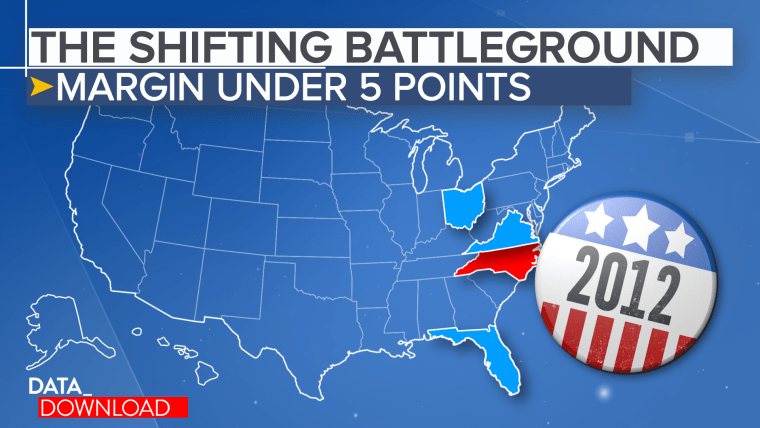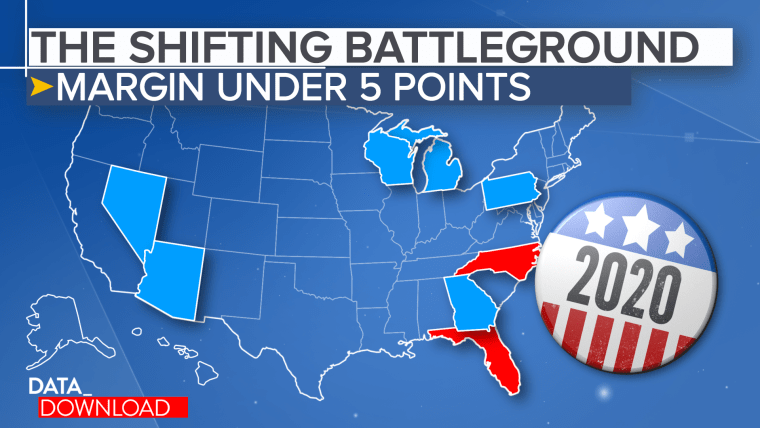WASHINGTON — The Electoral College ensures that every four years the race for the White House comes down to a few state battlegrounds that ultimately decide the winner. But those battlegrounds can change and in the last five presidential elections they have moved more than people think.
This year there were eight states where the presidential results were especially tight, less than a 5 point difference between the winner and loser in each. But since 2004, 20 different states have been in that group within 5 points, and the change in the states on the list reveals something about the changing nature of the American electorate.
Let’s start with 2004, President George W. Bush’s re-election effort. That list of close states will look familiar to those who have watched politics closely since the turn of the century. It bears the hallmarks of the Big 10 college athletic conference.
On the list: Iowa, Michigan, Minnesota, Ohio, Pennsylvania and Wisconsin. All six states were decided by less than 4 points. Also on the list were New Hampshire and two Southwestern states, Nevada and New Mexico.
In other words, the Midwest was the center of gravity for the swing states, Minnesota was just outside the eight closest states at number nine.
Also within 5 points and showing some of the movement in the West were Oregon and Colorado. Oregon was exiting the battleground list and Colorado was just about to enter it, both moving more Democratic.
By 2012, the year of President Barack Obama’s re-election campaign, the battlegrounds had developed a little more of a Southern flavor.

Moving onto the "within-5-points list" were Florida, North Carolina and Virginia. Ohio was still there representing Big 10 country. The 2012 numbers showed a larger evolution in the map and how Obama remade the it, at least for a short while.
Notably, Wisconsin and Michigan moved off the map entirely. Meanwhile, Colorado had gone from slightly Republican in 2004 to Democratic by a fairly comfortable margin. Once swing-y Oregon went to Obama by more than 12 points. And 2004 battleground New Mexico went to Obama by 10.
And that brings us to 2020, President Donald Trump’s re-election campaign and the battleground map we’ve all been staring at for the last week-and-a-half. It looks like a transitional map, partially rooted in the past, while also perhaps pointing a different electoral future.

Among the close states are the three Democratic “blue wall” territories recaptured in the Midwest — Michigan, Pennsylvania and Wisconsin. And there are the traditional battlegrounds of Florida, which Trump won by a little more than 3 points, and Nevada, which Biden won by a little less than 3.
But North Carolina is back on the list and very close, with Trump eking out a very narrow 1.4 point win. And, of course, there are the two big Democratic flips this year, Georgia and Arizona. Democratic President-elect Joe Biden won each by the exceedingly narrow margin of .3 percentage points and neither had gone Democratic in the presidential race since the last century.
In fact, since 2004, Arizona has only been in under-5-points group once before this election, in 2016. And Georgia had not been in the group at all. In both states the move toward Biden seems to have been powered by suburban voters.
But just as notable, look at the states not on the 2020 list. President Trump won Ohio, once a quintessential battleground, by 8 points. He won Iowa, a state carried twice by Barack Obama, by roughly the same margin. On the Democratic side, Biden won often-close New Hampshire by more than 7 points. Colorado went to Biden by more than 13 points.
And just off the list of closest states this year: Texas, which Trump is currently carrying by about 5.7 points.
Add it all up and the 2020 battlegrounds largely straddle the Industrial Midwest and the Sun Belt, with the latter region gaining momentum.
It’s too early to know if these battleground changes will last. So much of the last two presidential elections has been about people reacting to the current occupant of the White House. And the identities of the two major political parties are very much in flux. But with the 2020 results largely in, the road to the presidency looks very different than it did back in 2004 — and it has evolved since just four years ago.